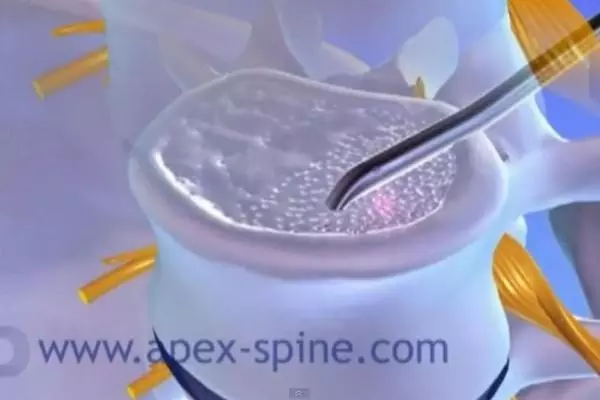Endoscopic refresher
Novel therapy for the regeneration of painful degenerative lumbar intervertebral discs
Every chronification of pain represents a challenge for the doctor. If conservative therapy measures such as physiotherapeutic and physical forms of treatment as well as targeted drug pain therapy do not lead to a significant improvement within 6 to 8 weeks, further differentiated research into the cause is important.
If back pain lasts longer than 6 weeks, it has become chronic back pain.
If the preliminary examinations have not resulted in a clear diagnosis, a discography of the pathologically altered intervertebral discs in the MRI is indicated. It can be determined whether there is a painful tear on the outer ring of the intervertebral disc (anulus). If necessary, the discography is combined with a computed tomography. If discography reveals a disc rupture, a percutaneous nucleotomy may be performed. In the case of significant intervertebral disc degeneration, which is limited to one or two intervertebral discs, after the discography has been carried out, a decision is made as to whether a discus plastic (endoscopic relief and freshening of the intervertebral disc), an intervertebral disc prosthesis or a spondylodesis (stiffening) is the best solution.
Do you have any complaints?
Then use our online questionnaire - professional initial assessment in 48 hours
How does the treatment work?
During endoscopic rejuvenation (revitalization) of the intervertebral disc, an optical endoscope equipped with various miniature working channels is carefully advanced percutaneously to the diseased intervertebral disc under local anesthesia. In order to support the revitalization of the intervertebral disc, the calcified cover plate of the adjacent vertebral bodies is freshened up under visual control using fine instruments, which improves blood circulation in the intervertebral disc and allows a firm, stable protective fiber ring to form.
Overall, the procedure takes about 30 to 45 minutes. The entry point is closed sterile with a small plaster.
The patient then comes to the recovery room for around 2 hours to be monitored. In patients who are in good general health, this procedure can also be performed on an outpatient basis.
A medical check-up takes place one day after the operation and then again three months later.
What aftercare is required?
A medical check-up takes place the day after the operation. In addition, a physiotherapist discusses the rehabilitation program that is individually tailored to the patient. In the first two weeks after the procedure, you will wear a specially adapted plastic corset that relieves your back and allows you to resume your usual activities soon. It is advisable to start physiotherapy tailored to your individual needs about a week after the operation under the supervision of a physiotherapist. After about 6 weeks you should start with muscle-strengthening exercises for the torso and back muscles. At the same time, a return to the usual physical activities (fitness and sport) is possible again.
You can also read detailed information on aftercare in our “Postoperative Program” instructions for download.
When can you do sports again?
You should be able to swim or cycle regularly again about four to six weeks after the procedure. You can resume your usual athletic training about six weeks after the procedure.
When are you able to work again?
After about two weeks you can resume office work and light physical work. You should avoid heavy physical activity for the first six weeks and then slowly increase it.
What is the success rate?
As an operative option, the international "golden standard treatment" for patients with pure back pain caused by a diseased or painful intervertebral disc is the intervertebral disc prosthesis or a spondylodesis (fusion) with all their advantages and disadvantages as well as complications.
This minimally invasive operation therefore represents a therapy attempt. Since there are no valid national or international studies on the endoscopic surgery (discoplasty) offered here. In our own study with a 2-year follow-up, a good or very good postoperative result was achieved in about 75% of the patients after one year and the patients were saved from an intervertebral disc prosthesis or a stiffening operation. (Source: M. John et al: The Percutaneous Transforaminal Endoscopic Disc Abrasion: A New Interventional Therapy for the Regeneration of Painful Degenerative Lumbar Discs, 2007)
The advantages at a glance:
- The procedure is performed under local anesthesia; no general anesthetic is necessary!
- Because hardly any tissue is destroyed, the procedure is less stressful and the risk of complications is low.
- No instability, since the spine has stabilizing structures (vertebral ligaments, vertebral joints)
be left perfectly intact; in contrast to the microscopic technique. - Reduced wound healing pain and increased stability,
since the back muscles do not have to be severed. - Lower risk of infection as access is through a small skin incision (5mm).
- Reduced scarring in the nerve root area!
- You can walk pain-free just two hours after the operation.
- No longer hospital stay is necessary: you can go home one day after the operation.
- You can go back to your usual activities just a few days after the operation.
- A short convalescence: After one to two weeks you are able to work again,
after about six weeks you can go back to your usual sports. - The operation hardly leaves any scars.


